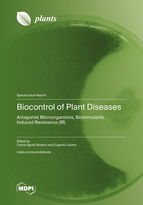Biocontrol of Plant Diseases: Antagonist Microorganisms, Biostimulants, Induced Resistance (IR)
A special issue of Plants (ISSN 2223-7747). This special issue belongs to the section "Plant Protection and Biotic Interactions".
Deadline for manuscript submissions: closed (30 April 2022) | Viewed by 37025
Special Issue Editors
Interests: biocontrol; etiology; epidemiology; fungi; integrated pest management; Mediterranean fruit crops; phytopathology; plant–pathogen–environment interactions; fungal trunk and vascular diseases
Special Issues, Collections and Topics in MDPI journals
Interests: plant microbiology; plant–microbe interaction; plant protection; induced resistance; plant physiology
Special Issues, Collections and Topics in MDPI journals
Special Issue Information
Dear Colleagues,
Biocontrol of plant diseases is considered one of the most important and current challenges of our society due to the need to look for eco-friendly alternatives against chemicals. Thus, research towards biological control sensu lato (antagonist microorganisms, biostimulants, induced resistance (IR)) for plant diseases is an urgent demand from the agro-food sector of the Euroregion, as well as for our society in the frame of European Green Deal. Exploring the different biocontrol tools as well as their combined effect against plant diseases is essential to generate knowledge on this topic to find optimum management strategies in crop protection in the frame of organic and sustainable agriculture. This Special Issue of Plants will bring together a collection of research papers on applied plant pathology and targeted reviews of biocontrol, including studies about antagonist microorganisms, biostimulants, and resistance host inducers against plant diseases.
Dr. Carlos Agustí-Brisach
Dr. Eugenio Llorens
Guest Editors
Manuscript Submission Information
Manuscripts should be submitted online at www.mdpi.com by registering and logging in to this website. Once you are registered, click here to go to the submission form. Manuscripts can be submitted until the deadline. All submissions that pass pre-check are peer-reviewed. Accepted papers will be published continuously in the journal (as soon as accepted) and will be listed together on the special issue website. Research articles, review articles as well as short communications are invited. For planned papers, a title and short abstract (about 100 words) can be sent to the Editorial Office for announcement on this website.
Submitted manuscripts should not have been published previously, nor be under consideration for publication elsewhere (except conference proceedings papers). All manuscripts are thoroughly refereed through a single-blind peer-review process. A guide for authors and other relevant information for submission of manuscripts is available on the Instructions for Authors page. Plants is an international peer-reviewed open access semimonthly journal published by MDPI.
Please visit the Instructions for Authors page before submitting a manuscript. The Article Processing Charge (APC) for publication in this open access journal is 2700 CHF (Swiss Francs). Submitted papers should be well formatted and use good English. Authors may use MDPI's English editing service prior to publication or during author revisions.
Keywords
- biological control agents
- biostimulation
- resistance host inducers
- sustainable agriculture








